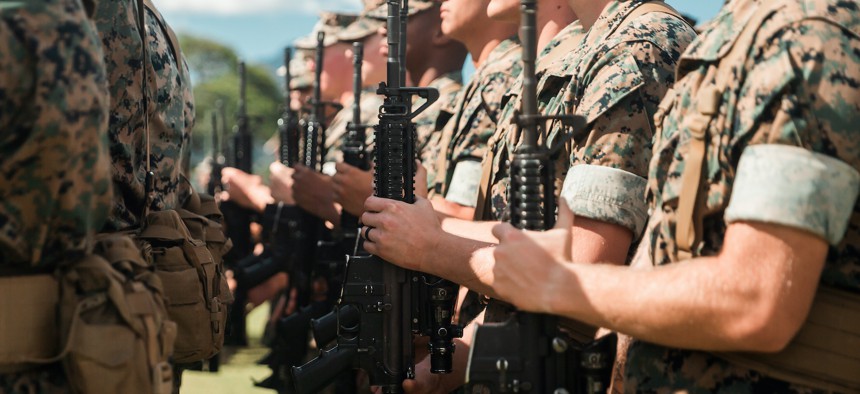
U.S. Marines with 3rd Marine Littoral Regiment, 3rd Marine Division present arms during the redesignation ceremony of 3rd Marines to 3rd MLR aboard Marine Corps Base Hawaii, March 3, 2022. The MLR is a key component of Commandant Gen. David Berger’s Force Design 2030 plan. U.S. Marine Corps / Cpl. Patrick King
Civilians Will Choose the Marine Corps’ Future—and Soon
And they will do it by selecting the next commandant and other four- and three-star generals.
A battle is underway for the future of the U.S. Marine Corps. It is being waged in print, in blogs, on Capitol Hill, at thinks tanks, and in the Pentagon. It has drawn in serving and retired Marines, all passionate about the future of their Corps. But the Corps’ ultimate direction will be set by senior civilian leaders—and sooner, perhaps, then anyone thinks.
The core issue is whether the Marines should continue to shift to the maritime littoral or revitalize its role as an autonomous, “first to fight” force. As physicist and philosopher of science Thomas Kuhn might have said, this is a choice between paradigms. Kuhn argued that most scientists—indeed, most people—work under an existing paradigm that assumes they know what the world is like. This paradigm drives the choice and construction of equipment, carries a set of rules, establishes the criteria for choosing problems, and provides the means to solve them. Eventually, though, even the strongest paradigm fails, and alternatives arise. When a particularly convincing alternative presents itself, Kuhn notes, it triggers a paradigmatic “crisis”: a difference so stark that one must decide to live in either the existing or emerging paradigms because one cannot live in both.
The Marines’ existing paradigm is championed by retired generals such as Charles Krulak and Anthony Zinni, following logic powerfully articulated by Krulak’s father, Victor Krulak, in First to Fight. In this vision, the Corps is perpetually under siege by Congress and the other services, but loved by the nation because it is an independent operating force, always ready to go whenever the country calls. Operational problems are secondary. What is paramount is that Marines will be first to address them. So, to ensure the Corps is ready when that call comes, it must be self-contained and retain its own complement of tanks and cannon artillery, among other things, to ensure it has whatever it needs.
Gen. David Berger, the current Commandant, offers a different paradigm. His Force Design 2030 identifies China’s increasing dominance in the Pacific as the critical, albeit not sole, problem. To address this “pacing challenge,” General Berger argues that the Corps must return to its maritime roots. He focuses on creating a “stand in” force to meet demands such as proliferated precision long-range fires, mines, and other smart weapons that are shaping a tough, contested operating environment. Moreover, rather than emphasize independent operations, he stresses the importance of the Corps’ responsiveness and relationship to the Navy and the joint force.
There is considerable overlap between the traditional and Force Design 2030 paradigms, but they represent two different understandings of the largest problem and how to solve it. This in turn compels different visions of how the Marine Corps should relate to the joint force and the nation. This explains why today’s Marine Corps leaders, even while keeping much of the Corps’ essence intact, find themselves under siege by those adhering to the traditional paradigm. The Corps, in short, is facing a crisis—and now must choose between the traditional paradigm and its increasing discontinuities or the new one and its unanswered questions.
To date, the most public manifestations of this crisis have concerned organizational, training, and equipment debates. Considerable discussion has also occurred over personnel issues such as lateral entry to the officer ranks. The most important personnel decisions, however, are not in this space; rather they are in the general officer ranks.
When the commandant states a position, it is usually considered synonymous with the Marine Corps’ position, and only infrequently does one hear dissenting voices from inside the Corps. Still, with distinguished retirees loudly proclaiming their disagreement with Berger, one must assume that many current senior Marines adhere to the traditional paradigm but feel duty-bound not to air their views.
This means that the most important decisions to resolve the Corps’ crisis are not about organizations, equipment, or training, but about the selection of the next generation of three- and four-star general officers—and particularly of a successor to General Berger, who is to retire next year. Ultimately, this person’s leadership will determine whether the Marine Corps continues with its Force Design 2030 shift or returns to its traditional paradigm.
Thus, despite the cacophony of serving and retired Marine Corps voices making cases for or against the paradigm shift, the most important voices belong not to Marines but senior civilian leaders in the Pentagon, at the White House, and on Capitol Hill. These civilians will set selection criteria, nominate, and then confirm the generals for these senior leadership positions.
But before they do so, these executive and legislative branch leaders—especially the Defense Secretary and president—must possess a strong sense of how the Marine Corps best fits into the joint force and serves the nation. These civilian leaders, too, must choose between the Force Design 2030 and traditional paradigms. Then they must discern which Marine Corps leaders adhere to the former and which to the latter. Not choosing is also a choice.
The interview, nomination, and confirmation processes can take several months. Now, not 2023, is the time for civilian defense leaders to settle on which paradigm is best for the joint force and the nation, and then to start evaluating closely who has the vision and tenacity to lead the Marine Corps in that direction.
Paula G. Thornhill is a retired U.S. Air Force brigadier general. She is an associate professor at Johns Hopkins University’s School of Advanced International Studies and author of "Demystifying the American Military."
Don't miss:
NEXT STORY: AUSA Conference Wire: Multi-Domain Drops





